The Royal Navy is entering a busy period as both HMS Prince of Wales and HMS Queen Elizabeth have set sail for equipment trials and training exercises.
HMS Queen Elizabeth departed Portsmouth on the 2nd of September at 12:10 PM, following extensive repairs and capability upgrades completed at Rosyth earlier this year.
This included critical work on the starboard propeller shaft coupling, which was necessary after a technical issue caused the vessel to withdraw from the NATO exercise Steadfast Defender. During that time, HMS Prince of Wales assumed operational responsibilities.
Summer leave over!
Good to be heading back to sea for a busy period of equipment trials and training. pic.twitter.com/Q7mLWZ6aUv
— HMS Queen Elizabeth (@HMSQNLZ) September 2, 2024
HMS Prince of Wales followed suit, setting sail this afternoon. Both vessels are the most powerful warships ever constructed for the Royal Navy, displacing approximately 65,000 tonnes and measuring 280 metres in length. Each carrier is capable of accommodating up to 40 aircraft, including advanced F-35B Lightning II stealth fighters and various helicopters.
HMS Queen Elizabeth, commissioned in December 2017, has already undertaken significant operational duties, including a global deployment in 2021. HMS Prince of Wales, commissioned in 2019, has also seen operational deployments to the United States and across Europe and the Arctic.
After a brief period of leave, we return to sea with our focus firmly on preparations for Operational Sea Training.#2QECAtSea#IServe pic.twitter.com/78CgueSoS1
— HMS Prince of Wales (@HMSPWLS) September 4, 2024
The Queen Elizabeth-Class Carriers
The Queen Elizabeth-class aircraft carriers measure 284 metres in length and have a standard displacement of approximately 65,000 tonnes. The design allows for this displacement to increase to over 70,000 tonnes as the ships undergo upgrades throughout their operational lifespan.
These carriers are manned by a core crew of about 679 personnel, which can expand to around 1,600 when including aircrew. The ships are equipped to carry up to 40 aircraft, predominantly featuring the advanced F-35B Lightning II stealth fighters.
The air wing typically comprises a combination of F-35B fighters and various rotary-wing aircraft, such as the Merlin HM2 and Wildcat. Additionally, the Royal Navy is exploring the integration of unmanned aerial vehicles (UAVs) to enhance operational flexibility. Trials are underway for systems like the General Atomics Mojave, which aims to support roles including strike operations and airborne early warning, reflecting the Royal Navy’s commitment to modernising its air capabilities.
In terms of propulsion, the Queen Elizabeth-class carriers utilise an Integrated Electric Propulsion system, consisting of two Rolls-Royce Marine Trent MT30 gas turbines and several Wärtsilä diesel generator sets. This configuration grants the vessels a range of approximately 10,000 nautical miles.
The flight deck of these carriers is designed to support a variety of rotary and fixed-wing aircraft. The hangar deck measures 155 by 33.5 metres, providing ample space to accommodate up to 20 aircraft. To facilitate quick transfers from the hangar to the flight deck, each carrier is equipped with two large lifts capable of moving aircraft efficiently.
For self-defence, the carriers employ the Phalanx Close-In Weapon System (CIWS) to counter potential airborne threats. In addition, the ships feature sophisticated radar systems, including the BAE Systems/Thales S1850M for long-range detection and the Artisan 3D radar system.
Finally, the Queen Elizabeth-class carriers are fitted with a highly mechanised weapons handling system, which streamlines the management of munitions on board. This system allows for efficient movement of palletised munitions from storage areas to the flight deck, minimising the need for manual handling and optimising operational readiness.


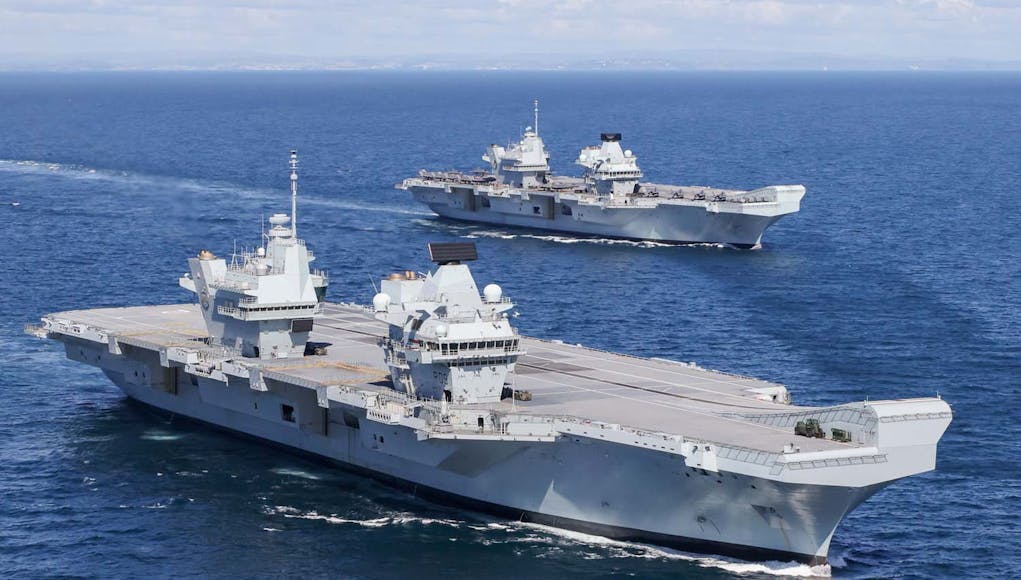

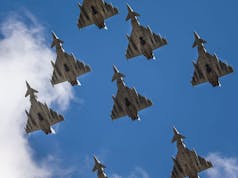
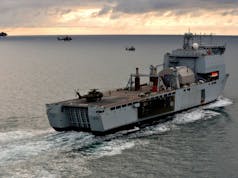
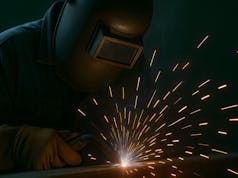

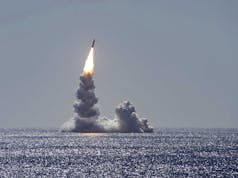

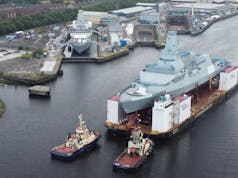



Theory: UK Defence Review will see one of these will being donated to Australia through auspices of AUKUS to be based in Pacific with AUKUS crewing to reduce RN crew required and MOD budget. An AUKUS platform for USMC/RAF/RN F35B detachments and Aus helos…
any tugboats with them?
Nah. they aren’t Russian.
They have both done long deployments without issue in the past.
Unfortunately the cheapening of the design from four to two shafts does have a robustness issue.
That said even with four shafts you would do a lot of damage to gland boxes and bearings unless the prop was bodily removed.
It would have been nice if they had at least had some emergency propulsion pods like on the Perry Class Frigates if they dropped the two shafts. Oh, well.
Perry class only had 1 shaft.
>Unfortunately the cheapening of the design from four to two shafts
I’m not sure that four shafts was ever seriously considered. Early CVF design concepts did have four propulsion pods, but it became clear that these were too vulnerable and could not be brought up to military robustness standards. When the French tried to adapt the CVF design to meet their requirement for a second aircraft carrier (PA2) they looked at adding a third shaft to increase speed for CTOL operations. Of course PA2 came to nothing, but only after paying the UK £120m for the CVF blueprints, support and assistance – they even had a c.20 strong project team based in Bath for 18 months!
There were so many variations on that design…I wasn’t there so I don’t know but I’ve seen a four shaft drawing and it would be easier to implement with IEP.
The irony is that it is probably the humongous amounts of power through those two shafts that shifts the QEC’s so fast on two shafts that causes the issue.
The top speed is already impressive and I’m not sure why you want to go a lot faster except if you needed to operate with a failed catapult?
Two at sea, and neither available for useful deployment, as always.
Was there a deployment planned then?
Je crois que oui, dans le pacifique !
No, but I would like to see one of them at least with a FULL complement of aircraft. Maybe in 2025 as previiously planned, assuming it can be afforded. 🙄
Empty flight decks ,still good Photo 📷 lightly hood soon down to one Carrier so enjoy pictures while we can guys 😏 oh pray I’m wrong 🙏
Et si ça continu, avec une probable baisse du budget, vous allez meme pas pouvoir compléter vo porte avion, mieux vaux les transformer en porte hélicoptère, moins chère, 1 porte avion avec 40 F35, et un porte hélicoptère !
Except they are both available as Helicopter carriers already. Nothing needs to be converted. Two adaptable carriers that can be strike, ASW, commando etc and with two hulls there is always one available. So not sure what your recommendation is?
Better two carriers than one I think. Far more flexibility and they are both very much complete. As for savings – as both carriers are complete there is no saving to be made there.
Short term savings are few and far between. Most costs like Type 26 won’t materialise for some time – so no financial benefits there. It’s possible that future drone tech might be accelerated but again that won’t save money today.
Mindestens haben wir zwei Flugzeugtraeger, und nicht ein LHD, wie die Franzosen die nicht einmahl ein einziges, richtiges, Flugzeugtrager bauen koennen. CdG, wen es funktzioniert, ist einfach zu kelin.
Im uebrigens Basile, ich schreibe auf Deutsch nicht weil du auf Frazoesich gepostest hast, sondern weil Deutsch deine mutter sprache waere ohne das Vereingtke Koenigreich.
Servus.
Anyone know what the equipment trials are ? Drones? USV’s ? CIWS ?
With nether Albion or Balwark available, I would like to see QE training with 5-6 mk4 comando merlins and a dozen Apache’s and possibly even four F35’s or drones suppling top cover. Gives options until MRSS turns up, if they ever do?
Do they have aircraft with them ? (Sarcastic comment) but i hope we fill these carriers soon or they really are a waste of space
While the rest of the navy is tied up alongside. Great
Are there escorts alongside due to a lack of crew or is it because they have other issues meaning they can’t put to sea ?
Both